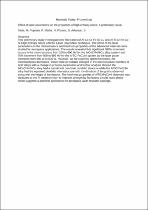 ResearchSpace
ResearchSpace
Effect of laser parameters on the properties of high entropy alloys: A preliminary study
JavaScript is disabled for your browser. Some features of this site may not work without it.
- ResearchSpace
- →
- Research Publications/Outputs
- →
- Journal Articles
- →
- View Item
| dc.contributor.author |
Dada, M

|
|
| dc.contributor.author |
Popoola, P

|
|
| dc.contributor.author |
Mathe, Ntombizodwa R

|
|
| dc.contributor.author |
Pityana, Sisa L

|
|
| dc.contributor.author |
Adeosun, S

|
|
| dc.date.accessioned | 2020-10-12T07:30:59Z | |
| dc.date.available | 2020-10-12T07:30:59Z | |
| dc.date.issued | 2020-05 | |
| dc.identifier.citation | Dada, M. (et.al). 2020. Effect of laser parameters on the properties of high entropy alloys: A preliminary study. Materials Today: Proceedings, 6pp. | en_US |
| dc.identifier.issn | 2214-7853 | |
| dc.identifier.uri | https://doi.org/10.1016/j.matpr.2020.04.198 | |
| dc.identifier.uri | https://www.sciencedirect.com/science/article/pii/S2214785320328133 | |
| dc.identifier.uri | http://hdl.handle.net/10204/11624 | |
| dc.description | Copyright: 2020 Elsevier. This is the abstract version of the work. For access to the fulltext version, kindly visit the publisher's website. | en_US |
| dc.description.abstract | This preliminary study investigates the fabrication of Al-Co-Cr-Fe-Ni-Cu and Al-Ti-Cr-Fe-Co-Ni High Entropy Alloys with the Laser Deposition Technique. The effect of the laser parameters on the microstructure and hardness properties of the advanced materials were studied for aerospace applications. The results revealed that significant 300% increment occurs in the microhardness from 200 to 600 HV for the AlCoCrFeNiCu alloy system and 70% increment from 500 to 850 HV for the AlTiCrFeCoNi system as the laser power increases from 600 W to 800 W. However, as the scanning speed increases, the microhardness decreases. There were no notable changes in the microstructure interface of both alloys with a change in process parameters and further analysis showed the AlCoCrFeNiCu alloy had a transitional columnar dendritic structure while the AlTiCrFeCoNi alloy had the equiaxed dendritic microstructure with the direction of the grains observed along with the height of the deposit. The hardness properties of AlTiCrFeCoNi observed was attributed to the Ti content known to improve strength by facilitating a solid laves phase which suggests a potential application for aerospace wear-resistant coatings. | en_US |
| dc.language.iso | en | en_US |
| dc.publisher | Elsevier | en_US |
| dc.relation.ispartofseries | Worklist;23790 | |
| dc.subject | Clad geometry | en_US |
| dc.subject | High entropy alloys | en_US |
| dc.subject | Laser additive manufacturing | en_US |
| dc.subject | Laser parameters | en_US |
| dc.subject | Preliminary studies | en_US |
| dc.title | Effect of laser parameters on the properties of high entropy alloys: A preliminary study | en_US |
| dc.type | Article | en_US |
| dc.identifier.apacitation | Dada, M., Popoola, P., Mathe, N., Pityana, S. L., & Adeosun, S. (2020). Effect of laser parameters on the properties of high entropy alloys: A preliminary study. http://hdl.handle.net/10204/11624 | en_ZA |
| dc.identifier.chicagocitation | Dada, M, P Popoola, Ntombizodwa Mathe, Sisa L Pityana, and S Adeosun "Effect of laser parameters on the properties of high entropy alloys: A preliminary study." (2020) http://hdl.handle.net/10204/11624 | en_ZA |
| dc.identifier.vancouvercitation | Dada M, Popoola P, Mathe N, Pityana SL, Adeosun S. Effect of laser parameters on the properties of high entropy alloys: A preliminary study. 2020; http://hdl.handle.net/10204/11624. | en_ZA |
| dc.identifier.ris | TY - Article AU - Dada, M AU - Popoola, P AU - Mathe, Ntombizodwa AU - Pityana, Sisa L AU - Adeosun, S AB - This preliminary study investigates the fabrication of Al-Co-Cr-Fe-Ni-Cu and Al-Ti-Cr-Fe-Co-Ni High Entropy Alloys with the Laser Deposition Technique. The effect of the laser parameters on the microstructure and hardness properties of the advanced materials were studied for aerospace applications. The results revealed that significant 300% increment occurs in the microhardness from 200 to 600 HV for the AlCoCrFeNiCu alloy system and 70% increment from 500 to 850 HV for the AlTiCrFeCoNi system as the laser power increases from 600 W to 800 W. However, as the scanning speed increases, the microhardness decreases. There were no notable changes in the microstructure interface of both alloys with a change in process parameters and further analysis showed the AlCoCrFeNiCu alloy had a transitional columnar dendritic structure while the AlTiCrFeCoNi alloy had the equiaxed dendritic microstructure with the direction of the grains observed along with the height of the deposit. The hardness properties of AlTiCrFeCoNi observed was attributed to the Ti content known to improve strength by facilitating a solid laves phase which suggests a potential application for aerospace wear-resistant coatings. DA - 2020-05 DB - ResearchSpace DP - CSIR KW - Clad geometry KW - High entropy alloys KW - Laser additive manufacturing KW - Laser parameters KW - Preliminary studies LK - https://researchspace.csir.co.za PY - 2020 SM - 2214-7853 T1 - Effect of laser parameters on the properties of high entropy alloys: A preliminary study TI - Effect of laser parameters on the properties of high entropy alloys: A preliminary study UR - http://hdl.handle.net/10204/11624 ER - | en_ZA |





